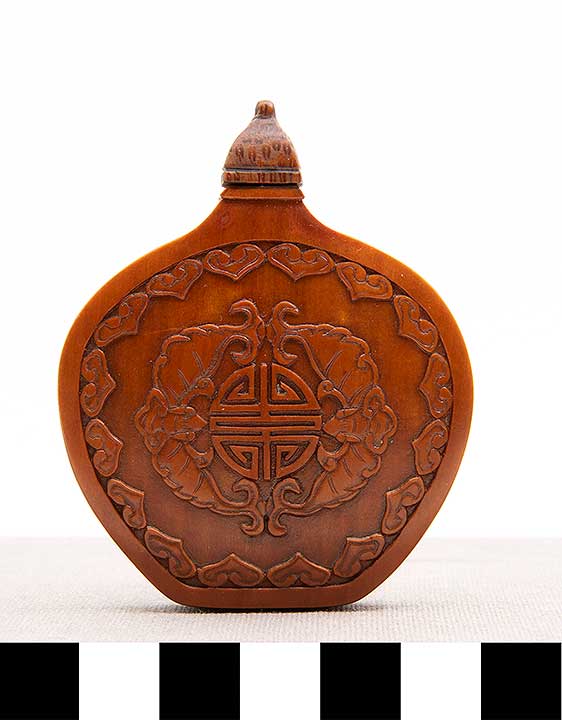Snuff Bottle
2012.12.0002A
Detailed Images
Basic Information
| Artifact Identification | Snuff Bottle (2012.12.0002A) |
|---|---|
| Classification/ Nomenclature |
|
| Artist/Maker | Imperial Workshops, Beijing |
| Geographic Location | |
| Period | Qianlong Period |
| Date | 18th century |
| Culture | N/A |
| Location | Not on Exhibit |
Physical Analysis
| Dimension 1 (Height) | 5.71 cm |
|---|---|
| Dimension 2 (Width) | 5.67 cm |
| Dimension 3 (Depth) | 1.51 cm |
| Weight | 12 g |
| Measuring Remarks | N/A |
| Materials | Plant--Bamboo |
| Manufacturing Processes | Carved |
Research Remarks
| Description | 6/28/2012: "An important Chinese bamboo veneer snuff bottle, Qianlong period, 18th century, attributed to the Imperial Workshops, Beijing, of flattened circular shape, termed a moon flask, with rounded shoulders sloping to a square neck and with a slightly averted mouth, each face applied and finely carved with a central shou character, flanked by a pair of archaistic bats encircled by a border of ruyi heads. The bats and shou motif form a rebus for Duofu duoshou (’Abundance and blessings of longevity’), 2 3/4” high, with original cap, original spoon, and ball finial, all features that are found in Imperial bamboo veneer snuff bottles. Another regular feature of many early Imperial snuff bottles: making it easier to remove, and the obviously original spoon reaches to within a couple of millimeters of the bottom of the hollowed area inside the bottle allowing for easy access and removal of the snuff. |
|---|---|
| Published Description | N/A |
| Bibliography | Under Review |
Artifact History
| Credit Line/Dedication | Fred A. Freund Collection |
|---|---|
| Reproduction | No |
Contact
All information about our collection is constantly reviewed and updated. Please contact Dery Martínez-Bonilla, Registrar, if there is any information you are looking for that isn't currently online.
